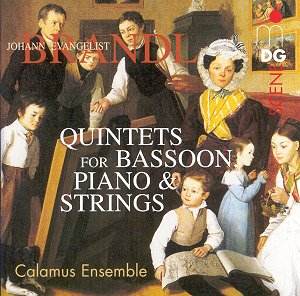You
have to give due credit to Dabringhaus und Grimm for delving into
the forgotten composersí archive. This second volume of works
from composer Johann Brandl has been unearthed and deserves to
be heard by a wide audience. Until these recordings became available
it is probable and rather amazing that these works were never
previously heard by an audience other than Brandlís immediate
employer and friends.
Brandl
was born in Bavaria in 1760 and it is said that his most important
works were composed from the late 1700s to around 1840. It was
in this period that chamber music as we know it today with one
instrument per part became established.
Brandl
received his first musical instruction at a Monastery and then
a catholic Seminary but was largely self-taught. It was whilst
in the employment of the Prince-Bishop of Speyer in Bruchsal that
Brandl found sufficient time to study mainly Haydn quartets and
symphonies and to compose in various genres. His tenure proved
to be difficult, unrewarding and not at all prestigious. Nevertheless
at the turn of the 17th century Brandl managed to compose a large
number of works some of which extended his reputation beyond his
immediate locality. Of those compositions, three quintets for
the combination of violin, viola, bassoon, cello and piano are
contained on this MDG release. In fact, MDG have already released
a previous volume of Brandl quintets: Op.14 and Op. 52 Nos. 1
and 2 on MDG 60311332, which although they seemed to pass most
critics by, are said to be well regarded.
The
composerís catalogue of works is incomplete with many scores thought
to be lost or destroyed. The Opus numbers are somewhat confusing
as those allocated to works bear little reference to their composition
dates.
It
is not known why Brandl wrote so many scores that featured the
bassoon. It is possible that he wrote them specifically for Jacques
Hartmann a wealthy client who was an enthusiastic amateur bassoonist.
None
of the original manuscripts for these three quintets exist and
the copies consist of separate parts for each individual instrument.
All the quintets here are piano quintets in all but name, owing
to the predominance of the piano writing, with the bassoon or
the violin occasionally taking over. In fact, at times I was reminded
of a piano concerto with string quartet accompaniment. In the
comprehensive booklet notes we are told that in accordance with
Style Galante the viola and cello simply take the middle
parts. Furthermore an interesting feature is how the bassoon parts
have been written to occasionally supplement the string writing,
as if it were a cello and a second viola.
It
is not surprising that there is a tremendous influence of Haydn
in these works and I certainly detect a flavour of Mozart; whose
music Brandl would have undoubtedly come across. The first quintet
on the release is in F major Op.13 (63) and is composed in the
Allegro, Andante, Allegro movement form. The quintet has
a dreamy texture in parts and is immediately attractive and satisfying.
The two remaining quintets in C major Op.61 in three movements
and the four movement F major Op. 62 are noticeably more intricate
and intense in style whilst still having the qualities of being
appealing and rewarding.
The
Calamus Ensemble are master musicians and provide exceptionally
fine and thoughtful playing throughout. I had not come across
the players previously and was most impressed. They are able to
expertly blend the necessary lyricism, playfulness and charm with
seriousness and imagination. The playing of pianist Sigrid Althoff
is particularly convincing in what is an extremely fine recital.
The recording offers clear separation of each instrument and has
striking presence.
Melodic,
appealing and rewarding Classical style piano quintets that are
predominantly Haydn influenced; with a hint of Mozart. Exceptional
performances from the Calamus Ensemble and well recorded too.
A most recommendable release.
Michael
Cookson
